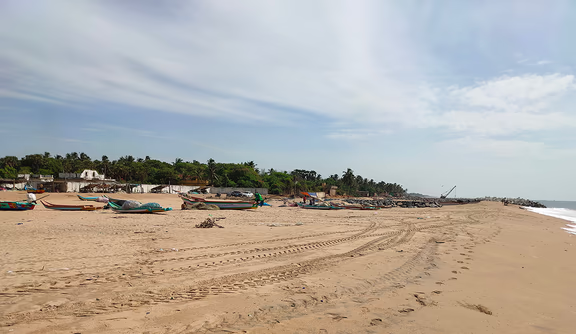Recovering lost beaches
FeatureBy Carel
Keywords: Quiet Healing Center, Repos beach community, Samarpan beach community, Samutra community, Gokulam beach community, Waves community, Halcyon - Varuna beach community, Simplicity beach community, Sri Ma / Far Beach, Beach erosion and Bommayarpalayam

The new beach at Halcyon (with the white wall) and Simplicity
Auroville has 10 beach communities. The most southern one, about six kilometres north of Pondicherry, is Quiet, home to the Quiet Healing Centre. 500 meters north are Samarpan, Samutra and Gokulam communities that offer guest accommodation and, a stone’s throw further, Repos and Waves. At another further 500 metres north, you find Halcyon (also known as Varuna beach, as this is the location for the future Auroville desalination plant) and Simplicity. The community of Sri Ma is about three kilometres north of Simplicity, and Eternity a three kilometres north of Sri Ma.
In the last decade, the southern beach communities have suffered badly from sea erosion. Beaches and vast tracts of land and buildings owned by Auroville have been lost to the sea. While Quiet, Samarpan, Samutra and Gokulam all lost more than 50 metres of their beach front land, Repos and Waves have virtually ceased to exist as almost all their land and buildings were swallowed by the sea. Halcyon and Simplicity escaped erosion but, during the last monsoon, the sea almost touched their fence.
Auroville’s efforts to protect the communities from further erosion have largely failed. In October 2019, helped with a private donation of Rs 13 Lakhs, Quiet hurriedly built a wall of sandbags to protect its land and buildings, which was completed just before the monsoon. It withstood the rather ‘gentle’ monsoon of 2019, but gradually disappeared under the battering waves of the heavy 2020 monsoon. “It effectively offered protection for two years,” says a Quiet executive. “We’ll have to see what happens this year.”
Samutra guesthouse was less lucky: one of its buildings is now on a precarious ridge and may well collapse into the sea during the next monsoon.
Vasu, a resident of Repos (the small part that is left of it), managed to get a donation of Rs 10 lakhs to build a concrete wall to protect it. But less than a year later a large part of the wall has already been undermined by the relentless sea.
Today, one finds a nice 60-metres wide beach at Quiet and a small beach that stretches from Samarpan to Waves. “It looks nice, but it really isn’t,” says Vasu. “The beach covers land that was once owned by Auroville. And these beaches may well disappear when the winter monsoon starts, and further erodes these communities.” “We have no security that our communities will remain safe,” says a resident of Quiet, resignedly.
The situation at Halcyon and Simplicity, however, has recently changed for the better. In November last year, the Tamil Nadu Government started a major shore protection project to prevent further erosion and reclaim the shoreline at Bommaiyarpalayam coast where the sea had caused damage to more than 70 houses. The Government is now building seven short groynes – barriers built out into the sea from the beach – of various lengths at a distance of approximately 200 metres from each other. The project is expected to reduce the intensity of the waves, prevent erosion, and provide safe boat-berthing beaches for the fishermen communities. The first one, just north of Simplicity, has already dramatically changed the landscape. While last year the sea licked its boundary wall, now a beautiful 40-metres wide beach has come into existence.
But not everybody is happy with the developments. “I’m doubtful that these groynes will be able to protect the Bommaiyarpalayam coast for a long time. For I think they are too short. We will see how they act when the next cyclone hits the area,” says Vasu. And he warns that the groynes may have a negative impact and erode the beach and Auroville land at Sri Ma and, ultimately, Eternity. For groynes don’t solve the problem of erosion; they merely transfer it elsewhere. Groynes interfere with the natural movement of sand up and down the coast, creating excess in some areas – mostly south of the groyne on our coastline – and serious erosion on the other side.
But what about the situation of Auroville’s southern beach communities? “Unless the Government of Tamil Nadu starts shore protection in these areas, the existence of these communities remains under threat,” says Vasu. “The Government should ask the National Institute of Ocean Technology to find a solution to save these communities and recover their lands and the beaches.”